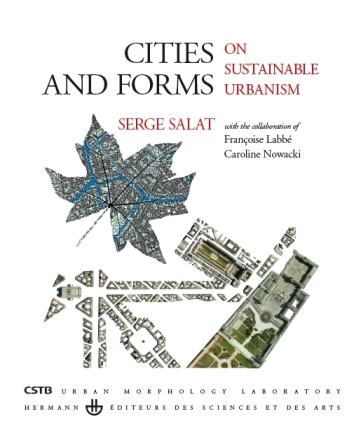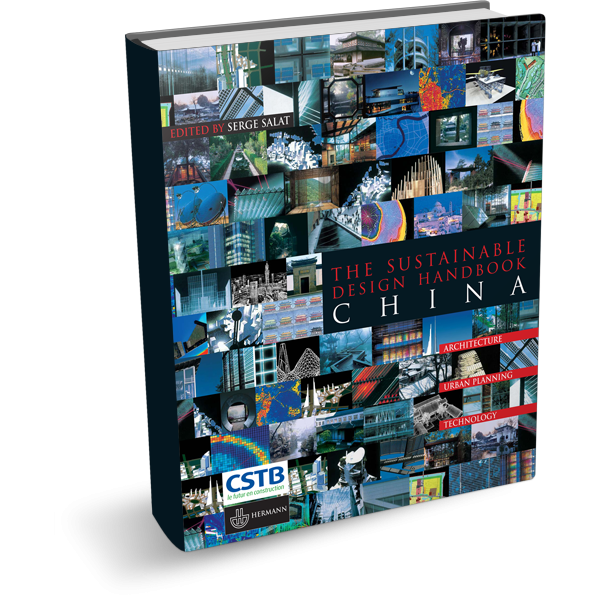Cities and Forms : On Sustainable Urbanism, Serge Salat with the collaboration of Françoise Labbé & Caroline Nowacki
 Cities and Forms probes the crucial issue of the shape to give to sustainable cities in the future. It unfolds a rich mosaic of two thousand years of urban history in the East and in the West through 1,200 drawings, city plans, and photographs, all of which is correlated with thousands of results of original analyses for a wide range of urban textures, from Siena and Venice to New York, Brasilia, Tokyo, Beijing, and Shanghai. Cities and Forms also features a detailed comparative study of Haussmanian Paris and Le Corbusier’s Radiant City, and an in-depth analysis of Chinese cities.
Cities and Forms probes the crucial issue of the shape to give to sustainable cities in the future. It unfolds a rich mosaic of two thousand years of urban history in the East and in the West through 1,200 drawings, city plans, and photographs, all of which is correlated with thousands of results of original analyses for a wide range of urban textures, from Siena and Venice to New York, Brasilia, Tokyo, Beijing, and Shanghai. Cities and Forms also features a detailed comparative study of Haussmanian Paris and Le Corbusier’s Radiant City, and an in-depth analysis of Chinese cities.
This book provides a measurable scientific dimension to such essential notions of sustainable urbanism as density, connectivity, functional mix, and accessibility, by exploring the qualities of historic urban fabrics. Readers will become familiar with organic patterns, grids, transformations, and the hidden order and fractal symmetries that connect urban scales, and endow the city with a meaningful, human order, which fosters social integration and cultural diversity, appropriable by residents but at the same time structured like an ecosystem. Morphology appears in this book as the key lever for cities to adapt to climate change. It enhances efficiency by cutting energy consumption in half. The connectivity of its networks reinforces urban re-silience, on the model of such natural structures as the hierarchic, intensely connected network of nervures in leaves. Cities and Forms develops a method of urban composition founded on perceptive qualities, and the design of public spaces, squares, streets, and visual sequences. It forms the bases of a return to the city as a place of memory and history, and of a controlled relationship between the urban fabric, urban morphology and building typology. By the abundance of its new findings, its methods and its concrete application of complexity theories, this book is of utmost importance to architects, urban planners, decision-makers, and anyone eager to understand sustainable cities and contribute to their development.
This major book on urban morphology has been published in English, French and Chinese.
The sustainable design handbook China, Serge Salat
 A 400-page manual with 800 illustrations. A comprehensive architectural and sustainable urban design handbook. The first design manual to integrate all scales : from the megalopolis to the choice of construction systems. A systematic and informative method that organises sustainable development issues and optimises choices. An extremely comprehensive document. A direct and efficient understanding of how to design sustainable cities and buildings. The first sustainable development guide to have been developed in coordination with Chinese partners, the handbook provides a specific and contextual approach to the immense-market represented by the 30 billion square metres of housing to be’ built and the population of 800 million people to be urbanised over the coming 20 years through the creation of 200 towns, each housing over two million inhabitants. This highly informative book explains fundamental principles through over 800 illustrations, diagrams, photographs and construction details. These are illustrated through 60 projects and completed works by major French and international architectural firms-such as Arte Charpentier, which participated in the preparation of the handbook, Renzo Piano, Richard Rogers, Norman Foster, Ken Yeang, Thomas Herzog, Bill Dunster, etc.
A 400-page manual with 800 illustrations. A comprehensive architectural and sustainable urban design handbook. The first design manual to integrate all scales : from the megalopolis to the choice of construction systems. A systematic and informative method that organises sustainable development issues and optimises choices. An extremely comprehensive document. A direct and efficient understanding of how to design sustainable cities and buildings. The first sustainable development guide to have been developed in coordination with Chinese partners, the handbook provides a specific and contextual approach to the immense-market represented by the 30 billion square metres of housing to be’ built and the population of 800 million people to be urbanised over the coming 20 years through the creation of 200 towns, each housing over two million inhabitants. This highly informative book explains fundamental principles through over 800 illustrations, diagrams, photographs and construction details. These are illustrated through 60 projects and completed works by major French and international architectural firms-such as Arte Charpentier, which participated in the preparation of the handbook, Renzo Piano, Richard Rogers, Norman Foster, Ken Yeang, Thomas Herzog, Bill Dunster, etc.
The book has been published in English and Chinese
